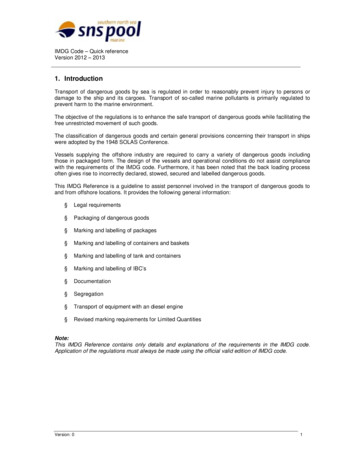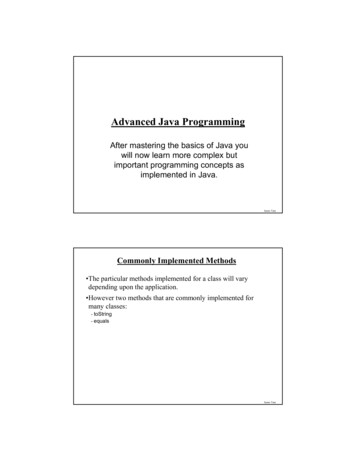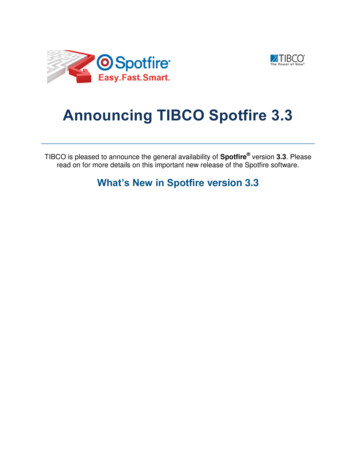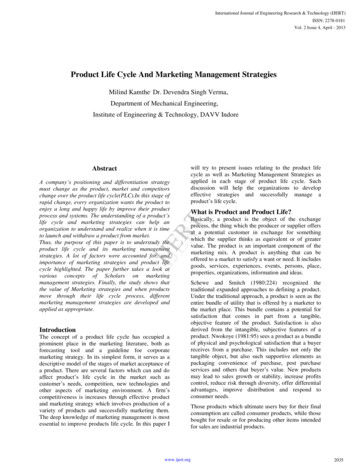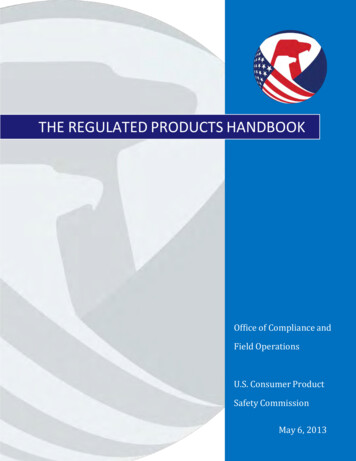
Transcription
THE REGULATED PRODUCTS HANDBOOKOffice of Compliance andField OperationsU.S. Consumer ProductSafety CommissionMay 6, 2013
ContentsPREFACE. 5CHAPTER 1—BASIC PRINCIPLES . 7HOW THE CONSUMER PRODUCT SAFETY COMMISSION (CPSC) ENFORCES ITSSTATUTES . 7REGULATED PRODUCT REQUIREMENTS . 8CERTIFICATES OF COMPLIANCE . 9REQUIREMENTS FOR CERTIFICATES OF COMPLIANCE . 9GENERAL CONFORMITY CERTIFICATES (GCCs) . 9CHILDREN’S PRODUCT CERTIFICATES (CPCs) . 9AVAILABILITY OF CERTIFICATES . 10ELECTRONIC FILING OF CERTIFICATES FOR IMPORTED PRODUCTS . 10CHAPTER 2—SANCTIONS UNDER CPSC STATUTES . 11PENALTIES. 11PENALTIES AVAILABLE UNDER THE CONSUMER PRODUCT SAFETY ACT (CPSA) . 11PENALTIES AVAILABLE UNDER THE FEDERAL HAZARDOUS SUBSTANCES ACT(FHSA) . 12PENALTIES AVAILABLE UNDER THE FLAMMABLE FABRICS ACT (FFA). 13PENALTIES UNDER THE POISON PREVENTION PACKAGING ACT (PPPA) . 14PENALTIES UNDER THE REFRIGERATOR SAFETY ACT (RSA), VIRGINIA GRAEMEBAKER POOL AND SPA SAFETY ACT (VGBA), and CHILDREN’S GASOLINE BURNPREVENTION ACT (CGBPA) . 14INJUNCTIVE ACTIONS . 15INJUNCTIONS UNDER THE CONSUMER PRODUCT SAFETY ACT (CPSA) . 15INJUNCTIONS UNDER THE FEDERAL HAZARDOUS SUBSTANCE ACT (FHSA) . 15INJUNCTIONS UNDER THE FLAMMABLE FABRICS ACT (FFA) . 15INJUNCTIONS UNDER THE POISON PREVENTION PACKAGING ACT (PPPA) . 15SEIZURE OF VIOLATIVE PRODUCTS . 16SEIZURE UNDER THE CONSUMER PRODUCT SAFETY ACT ( CPSA) . 16SEIZURE UNDER THE FEDERAL HAZARDOUS SUBSTANCE ACT (FHSA) . 16SEIZURE UNDER THE FLAMMABLE FABRICS ACT (FFA) . 17SEIZURE UNDER THE FOOD, DRUG, & COSMETIC ACT (FD&CA) . 17SEIZURE UPON REQUEST FOR REDELIVERY . 17CHAPTER 3—PRESENTING EVIDENCE THAT A PRODUCT IS NOT VIOLATIVE . 18RESPONDING TO THE CPSC LETTER OF ADVICE (LOA) . 18CPSC RESPONSE TO FIRM RESPONSE. 18LETTER OF ADVICE ISSUED FOR PRODUCT STOPPED AT PORT OF ENTRY. 19CHAPTER 4—REGULATED PRODUCTS AT PORT OF ENTRY . 20DETENTIONS. 20IMPORT AUTHORITY UNDER THE CONSUMER PRODUCT SAFETY ACT (CPSA) . 20EXPORTATION OF NONCOMPLYING GOODS AT PORT. 21IMPORT AUTHORITY UNDER THE FEDERAL HAZARDOUS SUBSTANCES ACT(FHSA) . 21Regulated Products Handbook ii
IMPORT AUTHORITY UNDER THE FLAMMABLE FABRICS ACT (FFA) . 22CHAPTER 5—RECALLING A REGULATED PRODUCT. 23PREPARING FOR A PRODUCT RECALL. 23ELEMENTS OF A RECALL. 24COMMUNICATING RECALL INFORMATION . 25NEWS RELEASES . 27RECALL ALERTS . 28VIDEO NEWS RELEASES . 28POSTERS. 29SOCIAL MEDIA . 30OTHER FORMS OF NOTICE. 30TOLL-FREE NUMBERS/E-MAIL/URL SITES . 31WEBSITE INFORMATION. 31CHAPTER 6—RECOMMENDED PROCEDURES FOR ESTABLISHING A RECALLPLAN WITHIN YOUR COMPANY . 33DESIGNATING A RECALL COORDINATOR . 33RESPONSIBILITIES OF A RECALL COORDINATOR . 33IDENTIFYING AFFECTED PRODUCTS . 33RECORDS MAINTENANCE . 34CONCLUSION . 35CHAPTER 7—DESTRUCTION OF A RECALLED PRODUCT. 36REVERSE DISTRIBUTING AND QUARANTINING PRODUCT . 36WITNESSING DESTRUCTION . 36USE OF THIRD PARTY DESTRUCTION CONTRACTORS . 36RECONDITIONING PRODUCT . 36PENALTIES FOR THE RESALE OF RECALLED PRODUCT . 37CHAPTER 8—APPLICATION FOR AUTHORIZATION TO RECONDITIONVIOLATIVE IMPORTS . 38PROCEDURES FOR OBTAINING AUTHORIZATION TO RECONDITION. 38COSTS CHARGEABLE IN CONNECTION WITH RECONDITIONING VIOLATIVEIMPORTS . 39CHAPTER 9—REPORTING REQUIREMENTS. 41STATUTORY REQUIREMENTS. 41REPORTING UNDER SECTION 15 OF THE CPSA . 41REPORTING PRODUCTS INVOLVED IN LAWSUITS . 42REPORTING CERTAIN CHOKING INCIDENTS . 42WHY REPORTING IS REQUIRED . 42WHEN TO REPORT UNDER SECTION 15 OF THE CPSA. 43REPORTING PROCEDURES. 44PENALTIES FOR FAILURE TO REPORT . 44CHAPTER 10—EXPORT REQUIREMENTS . 46POLICY STATEMENT REGARDING PROHIBITION OF EXPORTATION. 46PRODUCTS SUBJECT TO THE CONSUMER PRODUCT SAFETY ACT (CPSA) . 46PRODUCTS SUBJECT TO THE FEDERAL HAZARDOUS SUBSTANCES ACT (FHSA) . 46PRODUCTS SUBJECT TO THE FLAMMABLE FABRICS ACT (FFA) . 46Regulated Products Handbook 3
PROHIBITIONS ON EXPORTATION . 47EXPORT NOTIFICATION REQUIREMENTS . 47CONSUMER PRODUCT SAFETY ACT (CPSA) VIOLATIONS . 48FEDERAL HAZARDOUS SUBSTANCES ACT (FHSA) VIOLATIONS . 48FLAMMABLE FABRICS ACT VIOLATIONS (FFA) . 48CHAPTER 11—CONFIDENTIAL TREATMENT OF INFORMATION . 49CONFIDENTIALITY OF INFORMATION UNDER SECTION 6 OF THE CONSUMERPRODUCT SAFETY ACT (CPSA) . 49CONFIDENTIALITY OF REPORTS UNDER SECTION 15(b) OF THE CONSUMERPRODUCT SAFETY ACT (CPSA) . 50CONFIDENTIALITY OF REPORTS UNDER SECTION 37 OF THE CONSUMERPRODUCT SAFETY ACT (CPSA) . 50USE OF INFORMATION BY THE COMMISSION . 51SHARING OF INFORMATION WITH FEDERAL, STATE, LOCAL, AND FOREIGNGOVERNMENT AGENCIES . 51Regulated Products Handbook 4
REGULATED PRODUCTS HANDBOOKPREFACEThe U.S. Consumer Product Safety Commission (CPSC or Commission), established byCongress in 1972, is an independent federal regulatory agency charged with reducingunreasonable risks of injury and death associated with consumer products. The CPSCachieves that goal through education, safety standards activities, regulation, andenforcement of the statutes and implementing regulations. TheCPSC has jurisdiction over thousands of types of consumer products used in thehome, in schools, in recreation, or otherwise. To carry out its mission, CPSCadministers seven statutes passed by Congress (the Acts). They are:1.2.3.4.5.6.Consumer Product Safety Act (CPSA), 15 U.S.C. §§ 2051-2089;Federal Hazardous Substances Act (FHSA), 15 U.S.C. §§ 1261-1278Flammable Fabrics Act (FFA), 15 U.S.C. §§ 1191-1204;Poison Prevention Packaging Act (PPPA), 15 U.S.C. §§ 1471-1477;Refrigerator Safety Act (RSA), 15 U.S.C. §§ 1211-1214;Virginia Graeme Baker Pool and Spa Safety Act (VGBA),15 U.S.C. §§ 8001-8008; and7. Children’s Gasoline Burn Prevention Act (CGBPA), 110 P.L. 278.This Handbook has been developed to assist manufacturers, importers, retailers andothers in the regulated community (firms) in understanding their responsibilitiesunder the Acts and what steps they should take when either the CPSC staff informsthem, or they become aware of, a violation of CPSC statutes and regulations. WhenCPSC staff determines that a product violates a specific statute or regulation, CPSCOffice of Compliance and Field Operations generally notifies the responsible firm(the product manufacturer, importer, distributor, or retailer) of the violation andrequests a specific remediation of the problem.Notification to the responsible firm is usually in the form of an official letter, referredto in this Handbook as the Letter of Advice or a Notice of Noncompliance from theOffice of Compliance and Field Operations (collectively referred to in this Handbookas LOA). Firms should review this Handbook in conjunction with the LOA sent byCPSC staff that identifies the applicable statutes and regulations violated. The LOAinforms the firm of the specific product and violation that has occurred; requeststhat the firm take specific corrective actions (including stopping the sale anddistribution of the product; recalling the product from distributors, retailers, and/orconsumers; quarantining and disposing of inventory of the product; andchanging future production of the product); and informs the firm of the legal actionsavailable to the Commission (including civil and criminal penalties and injunctiverelief). In addition, the LOA informs the firm that if it disagrees with CPSC staff’sdetermination that a violation has occurred or believes the product is not subject toRegulated Products Handbook 5
the Commission’s jurisdiction, it may question staff’s findings and present evidenceto support its position. See Chapter 3 of this Handbook.After reviewing the information in the chapters that follow, please direct anyquestions to the appropriate CPSC Compliance Officer or the Office of Complianceand Field Operations at Sect15@cpsc.gov.Regulated Products Handbook 6
CHAPTER 1 – BASIC PRINCIPLESHOW CPSC ENFORCES ITS STATUTESThe goal of the Commission’s Compliance Program is to ensure that firms complywith the statutes, rules, regulations, standards, and bans that protect consumersfrom hazardous products. To achieve this goal, the agency conducts three maintypes of compliance activities: Informing stakeholders or the regulated community of CPSCrequirements for their products through education, workshopsand seminars, and written informational letters, includingguidelines and other publications, as appropriate. Maintaining surveillance over consumer products by monitoringconsumer incidents, following up on reports by entering andinspecting any factory, warehouse or establishment whereconsumer products are manufactured or held, or any firewalledconformity assessment bodies, and sampling and testing suchproducts that may not be in compliance with federal standards orthat may be potentially hazardous products. Testing consumer products to the mandatory requirements,identifying noncompliance, and obtaining corrections ofnoncompliant products (primarily by working cooperatively withindustry, but initiating litigation when necessary) throughreconditioning and recalls of hazardous products from themarketplace or consumers.Specific compliance activities regarding enforcement include the following: Monitoring compliance with statutes, rules, standards, regulations,bans, and other requirements and enforcing existing regulationsand laws by: (1) conducting both domestic surveillance throughinspections of manufacturers, importers, distributors, andretailers of consumer products and import surveillance at ports ofentry in conjunction with U.S. Customs and Border Protection(CBP or Customs); and (2) investigating injury reports, consumercomplaints, trade complaints, or other allegations or indicationsthat a firm is manufacturing or distributing consumer productsnot in compliance with a statute, rule, regulation, standard, or banunder our authority. Section 15 of the CPSA requires manufacturers, distributors, andretailers to report to the CPSC, among other things, products thatfail to comply with an applicable consumer product safety ruleunder the CPSA or any other similar rule, regulation, standard, orban under the CPSA or any statute enforced by the CPSC. With the passage of the Consumer Product Safety ImprovementAct (CPSIA) in August 2008, if a product violates a mandatoryRegulated Products Handbook 7
requirement under the FHSA, FFA, PPPA, RSA, VGBA, or CGBPA,the firm must report the violation to the CPSC.Section 37 of the CPSA requires manufacturers to report to theCommission products that are the subject of at least three civilactions within a 24-month period that result in a judgment or finalsettlement in favor of the plaintiff.The Commission has theauthority to remove hazardous products from the marketplaceunder sections 12, 15 and 22 of the CPSA; sections 6 and 15 of theFHSA; and section 6 of the FFA.REGULATED PRODUCT REQUIREMENTSThe CPSC does not have premarket authority to “approve” a product prior to itsimportation and distribution in commerce. Manufacturers and importers areresponsible for ensuring that their products meet any mandatory standards orregulations prior to those products being distributed in commerce, in mostsituations. Title 16 of the Code of Federal Regulations (CFR) contains implementingregulations of the above statutes. The regulations are organized by the statute ofauthority. Some of the requirements for consumer products are statutoryrequirements and are not represented by a corresponding mandatory standard orregulation. For example, the Children’s Gasoline Burn Prevention Act places specificrequirements on manufacturers and importers of portable gas cans that are notdelineated in the CFR. The specific requirements for portable gas cans are statutory,110 P.L. 278; 122 Stat. 2602; 2008 [H.R. 814], July 17, 2008.The Consumer Product Safety Improvement Act of 2008 added statutoryrequirements for specific children’s products. Section 101— lead requirements(regarding lead content), section 103— tracking requirements, section 105—advertising for catalogs and direct means of sale requirements, section 106— ToySafety Standard, and section 108— prohibition on certain phthalates, may not havecorresponding regulations in the CFR. Information on the requirements areascertained through review of the CPSIA. Many of the new rules mandated bysection 104 of the CPSIA incorporate the performance requirements of a voluntaryconsensus standard into a mandatory rule. Due to copyright protection of thesestandards, however, the specifics of the standards are incorporated by reference inthe CPSC rules. The full standard must be obtained from the consensus standardorganization and is not codified in the CFR. The specific version that was accepted bythe Commission at the time of the rulemaking may be revised or updatedperiodically to a more current version that becomes accepted by the CPSC. A list ofthe accepted version and the acceptance dates is maintained on the CPSC sting/.In addition to meeting the requirements of a specific regulation, some productcategories must meet requirements of multiple regulations. For example, anyproduct that is manufactured for children has requirements that apply to allchildren’s products, in addition to performance requirements for that product.Regulated Products Handbook 8
Thus, a full-size crib must meet the requirements of 16 CFR part 1219— SafetyStandard for Full-Size Baby Cribs; the requirements for lead in surface coatings (Banof Lead-Containing Paint and Certain Consumer Products Bearing Lead ContainingPaint, 16 CFR part 1303); lead content limits (section 101 of the CPSIA); thephthalate limits (section 108 of the CPSIA); tracking label requirements (section103 of the CPSIA); certification requirements (16 CFR part 1110); and,Requirements for Consumer Registration of Durable Infant and Toddler Products,16 CFR part 1130. The requirements for children’s products span several rules.Below is a summary of the additional requirements.CERTIFICATES OF COMPLIANCEREQUIREMENTS FOR CERTIFICATES OF COMPLIANCESection 14 (a)(1) and (2) of the CPSA, 15 U.S.C. § 2063(a)(1) and (2), states that“every manufacturer” of a product, including a children’s product, subject to aconsumer product safety rule, ban, standard, or regulation, as well as the privatelabeler of such product, must issue the certificates described in section 14(a) of theCPSA. Section 3(a)(11) of the CPSA defines the term “manufacturer” as any personwho manufactures or imports a consumer product. As such, any statutory obligationassigned to a manufacturer, by definition, applies to an importer.Shortly after passage of the CPSIA in 2008, the Commission issued a regulation, at16 CFR part 1110, to specify the persons required to issue certificates under section14(a) of the CPSA. Section 1110.7 states that certificates for products manufacturedoutside the United States must be issued by the importer, and certificates forproducts manufactured within the United States must be issued by themanufacturer.GENERAL CONFORMITY CERTIFICATES (GCCs)Section 14(a)(1) of the CPSA requires every manufacturer and private labeler of aproduct subject to a consumer product safety rule under the CPSA or similar rule,ban, standard, or regulation enforced by the Commission, to issue a certificate ofcompliance for any product that is imported for consumption or warehousing ordistributed in commerce. The certificate must certify that the product complieswith all applicable CPSA consumer product safety rules and similar rules, bans,standards, or regulations under any other statutes administered by the Commission.The certificate must specify each such rule, ban, standard, or regulation with whichthe product must comply. In general, the certification must be based on a test ofeach product or upon a reasonable testing program.CHILDREN’S PRODUCT CERTIFICATES (CPCs)Section 14(a)(2)(B) of the CPSA requires every manufacturer and private labeler ofa children’s product subject to a children’s product safety rule to issue a certificatethat certifies that such children’s product complies with the children’s productsafety rule based on testing by accredited third party conformity assessment bodiesRegulated Products Handbook 9
that have been accepted by the Commission. The certificate must be issued beforeimporting for consumption or warehousing or distributing into commerce any suchproduct. See information on Children’s Product Certificates Certificate-CPC/. The Commissionmaintains on the website a listing of the accepted accredited third party conformityassessment bodies nufacturing/Lab-AccreditationAVAILABILITY OF CERTIFICATESSection 14(g)(3) of the CPSA requires every certificate under section 14 of the CPSAto accompany the applicable product or shipment of products covered by the samecertificate and a copy of the certificate to be furnished to each distributor or retailerof the product. Upon request, the manufacturer or private labeler issuing thecertificate must furnish a copy of the certificate to the Commission.ELECTRONIC FILING OF CERTIFICATES FOR IMPORTED PRODUCTSSection 14(g)(4) of the CPSA authorizes the Commission, in consultation with CBP,to provide for the electronic filing of certificates up to 24 hours before arrival of animported product. Upon request, the manufacturer or private labeler issuing thecertificate must furnish a copy to the Commission and to CBP.Regulated Products Handbook 10
CHAPTER 2 – SANCTIONS UNDER CPSC STATUTESWith the enactment of various statutes administered by the CPSC, Congress providedspecific sanctions that may be imposed against firms or individuals that violate anyprovision of the statutes. These sanctions include both civil penalties, up to amaximum of 15.15 million (76 Federal Register 71554, November 18, 2011); andcriminal penalties, including a fine, imprisonment of the responsible individual(s) fornot more than five years, and forfeiture of assets associated withthe criminal violation(s). In addition, firms and individuals may be enjoined fromcontinuing to violate CPSC statutes and regulations, and pursuant to court order,violative products may be seized to prevent distribution in commerce.PENALTIESThe CPSC Office of Compliance and Field Operations issues a letter of advice (LOA)to the responsible individual and firm when a product is found to violate a CPSCstatute, safety standard, or banning regulation. The notice of noncomplianceinforms the firm of which statutes, rules, regulations, standards, or bans have beenviolated, and it specifies the prohibited acts that have occurred.The prohibited acts are found in section 19 of the CPSA, 15 U.S.C. § 2068; section 4of the FHSA, 15 U.S.C. § 1263; section 3 of the FFA, 15 U.S.C. § 1192; and sections403, 502, and 602 of the Federal Food, Drug, and Cosmetic Act (FD&CA), 21 U.S.C. §§343, 352, and 362 for violations involving foods, drugs, and cosmetics subject to thespecial packaging standards under the Poison Prevention Packaging Act (PPPA).Violations of the RSA, VGBA, and CGBPA are prohibited acts under section 19 of theCPSA.The LOA will provide the maximum sanctions to which the firm and/or individualmay be subject. Generally, the LOA will not contain specific details regardingpenalties, but it will refer to this Handbook for assistance in determining theapplicable penalties available under the CPSA, FHSA, FFA, PPPA (enforced throughthe FHSA and Food Drug &Cosmetic Act (FD&CA)) and the RSA, VGBA, and CGBPA(enforced through the CPSA).PENALTIES AVAILABLE UNDER THE CONSUMER PRODUCT SAFETY ACT (CPSA)Civil Penalties under the CPSA—Under section 20 of the CPSA, any person whoknowingly 1 violates section 19 of the CPSA shall be subject to a civil penalty not toexceed 100,000 for each such violation. 2 With some exceptions, a violation ofsection 19(a)(1), (2), (4), (5), (6), (7), (8), (9), (10), or (11), shall constitute a“Knowingly” is defined at §20(d) of the CPSA, 15 U.S.C. § 2069(d).The maximum penalty amounts are adjusted for inflation every five years. The next adjustment willoccur on January 1, 2017. See 15 U.S.C. § 2069 (a)(3)(A) [CPSA]; 15 U.S.C. § 1265(c)(5) [FHSA]; and15 U.S.C. §1194(e)(5)(A) [FFA].12Regulated Products Handbook 11
separate offense with respect to each individual consumer product involved, exceptthat the maximum civil penalty shall not exceed 15.15 million for any related seriesof violations. (76 Federal Register 71554-55, November 18, 2011)Criminal Penalties under the CPSA —Under section 21 of the CPSA, 15 U.S.C. §2070, violation of section 19 of the CPSA is punishable by:1. imprisonment of not more than five years for a knowing and willfulviolation;2. a fine determined under section 3571 of Title 18, United States Code;or3. both.The Criminal Fine Improvements Act of 1987, Pub. Law 100-185, [18 U.S.C. § 3571]increased maximum criminal penalties under the CPSA to 100,000 for individualsand 200,000 for organizations, unless a death occurred, in which case themaximum fine is 250,000 for individuals and 500,000 for organizations.2In addition to the criminal penalties described above, the penalty for a violation ofthe CPSA, or any other act enforced by the Commission, may include the forfeiture ofassets associated with the violation.PENALTIES AVAILABLE UNDER THE FEDERAL HAZARDOUS SUBSTANCES ACT(FHSA) 3Civil Penalties under the FHSA— Under section 5(c)(1) of the FHSA, any personwho knowingly violates section 4 of the FHSA shall be subject to a civil penalty notto exceed 100,000 per violation.2 In addition, under section 20 of the CPSA, anyperson who knowingly violates section 19 of the CPSA shall be subject to a civilpenalty. The term “knowingly” is defined in section 5(c)(5) of the FHSA. 15 U.S.C. §1264(c)(5). The Commission may seek a civil penalty of up to 100,000 pernoncompliant (violative) product, up to a maximum of 15.15 million for anyrelated series of violations. (76 Federal Register 71554, November 18, 2011).Criminal Penalties under the FHSA—Under section 5(a) of the FHSA, 15 U.S.C. §1264(a), any person who violates any provisions of section 4 of the FHSA shall beguilty of a misdemeanor and shall, upon conviction thereof, be subject to a fine notto exceed 10,000 for organizations and not more than 5,000 or imprisonment fornot more than 90 days, or both, for individuals. [18 U.S.C. § 3571]For offenses committed with intent to defraud or mislead, or for second andsubsequent offenses, the penalty shall be imprisonment of not more than five years,a fine determined under 18 U.S.C. § 3571, or both. For organizations, the maximum3 In addition to these FHSA penalties, CPSIA made most violative conduct that is punishable underthe FHSA also punishable under the CPSA.Regulated Products Handbook 12
fine is 200,000 if the offense does not result in death or a maximum fine of 500,000 if the offense results in death. For individuals, the maximum fine is 100,000 if the offense does not result in death and a maximum fine of 250,000 ifthe offense results in death. [15 U.S.C. § 3571] Section 217(d) of the CPSIAincreased the maximum criminal penalties provided for in section 5(a) of the FHSA. 4PENALTIES AVAILABLE UNDER THE FLAMMABLE FABRICS ACT (FFA) 5Civil Penalties under the FFA— Under section 5(e) of the FFA, any person whoknowingly violates a standard or regulation issued under section 4 of the FFA, 15U.S.C. § 1193, shal
REGULATED PRODUCTS HANDBOOK . PREFACE. The U.S. Consumer Product Safety Commission (CPSC or Commission), established by Congress in 1972, is an in



